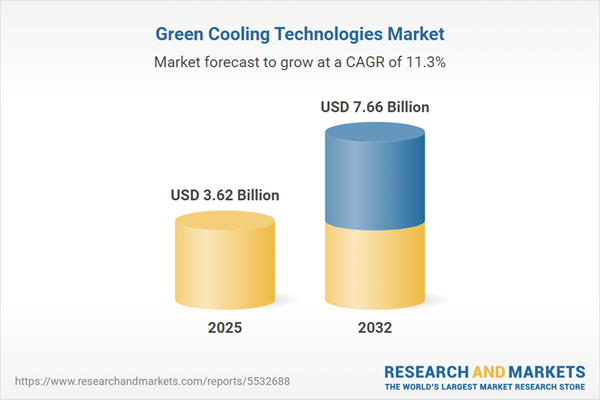Speak directly to the analyst to clarify any post sales queries you may have.
Green cooling technologies are redefining how enterprises balance environmental responsibility with essential operational objectives. As organizations face mounting regulatory pressures and sustainability targets, investment in advanced cooling solutions is becoming central to maintaining both compliance and business continuity.
Market Snapshot: Green Cooling Technologies Market
The green cooling technologies market is experiencing robust expansion, driven by heightened regulatory requirements and corporate sustainability goals. Organizations across multiple sectors are rapidly modernizing their cooling infrastructures, phasing out legacy systems in favor of environmentally friendly alternatives to achieve long-term operational agility and reliability. This transformation is not only improving system performance but also extending asset lifespans and reducing operational risks. As adoption rates accelerate, the market reflects both regulatory impetus and a strategic corporate pivot toward low-impact, resilient infrastructure on a global scale.
Scope & Segmentation
This report delivers in-depth segmentation intended to support senior leaders in evaluating sustainable cooling strategies, selecting procurement models, and managing operational risks linked to evolving regulations and technology landscapes. Each segment highlights opportunities to align infrastructure investments with compliance and resilience goals:
- Technology: Absorption, adsorption, magnetocaloric, Stirling cycle, and thermoelectric systems create pathways to customize compliance strategies, adapt to unique operational contexts, and mitigate associated risks.
- Power Source: Electric, solar, hybrid, and waste-heat recovery platforms broaden organizations’ autonomy over energy choices while easing environmental impacts in commercial and industrial environments.
- Cooling Capacity: Large-scale installations suit data centers and manufacturing, while mid-sized and compact systems address retail, hospitality, office complexes, and distributed multi-site networks.
- Component: Compressors, control units, expansion valves, and heat exchangers are vital for ensuring long-term reliability and asset protection throughout diverse system types.
- End Use: Hospitality, office, retail, data center, pharmaceutical, food processing, residential, and transportation markets utilize green cooling to address sector-specific compliance, energy, and sustainability needs.
- Distribution Channel: Digital procurement approaches increase sourcing transparency and flexibility, enabling timely adaptation to shifting regional and project-specific requirements.
- Geographical Coverage: The market spans the Americas, EMEA, and Asia-Pacific, reflecting distinct regional adoption pathways and regulatory drivers shaping sustainable cooling initiatives.
- Company Coverage: Evaluation includes Daikin Industries, Carrier Global, Johnson Controls International, Ingersoll Rand, Emerson Electric, Danfoss, Mitsubishi Electric, LG Electronics, Midea Group, and Panasonic Holdings—spotlighting innovation and competitive positioning.
Key Takeaways for Senior Decision-Makers
- Flexible green cooling strategies equip organizations to navigate frequent regulatory changes and promote business resilience through uninterrupted operations.
- Advanced digital monitoring technologies and predictive maintenance protocols enhance performance and enable proactive infrastructure management across complex asset portfolios.
- Transparency in procurement builds project reliability and strengthens risk management in compliance-intensive environments.
- Differing approaches are notable across regions: the Americas prioritize upgrades and retrofitting, EMEA focuses on adapting to regulatory change, and Asia-Pacific targets scale through digitization and system modernization.
- Collaborative efforts among OEMs, technology suppliers, and utilities are accelerating sector growth, advancing standards, and enhancing cross-value chain knowledge transfer.
- Expansion of digital supply platforms gives organizations broader sourcing options and greater alignment with evolving sustainability requirements and operational targets.
Tariff Impact: Strategic Implications of U.S. Trade Policy
Recent U.S. tariffs on imported cooling components are influencing sourcing decisions for manufacturers. This climate promotes nearshoring, dual sourcing, and modular design—driving supply chain resilience and minimizing exposure to ongoing trade shifts.
Methodology & Data Sources
This report draws on executive interviews, end-user surveys, peer-reviewed literature, regulatory documentation, and patent analyses. A rigorous triangulation of sources delivers reliable guidance to inform strategic decision-making in green cooling investments.
Why This Report Matters
- Equips organizations with actionable frameworks for benchmarking and refining strategy within the green cooling technologies market.
- Enables adaptation of procurement and compliance functions to support changing regulations and seamless integration of next-generation cooling innovations.
- Supports the identification of optimization levers to drive progress toward both sustainability and operational objectives.
Conclusion
Green cooling technologies are integral to enhancing organizational reliability and achieving ambitious sustainability benchmarks. This report delivers the actionable insights executives need to lead infrastructure investments with confidence amid market transformation.
Additional Product Information:
- Purchase of this report includes 1 year online access with quarterly updates.
- This report can be updated on request. Please contact our Customer Experience team using the Ask a Question widget on our website.
Table of Contents
3. Executive Summary
4. Market Overview
7. Cumulative Impact of Artificial Intelligence 2025
List of Figures
Companies Mentioned
The companies profiled in this Green Cooling Technologies market report include:- Daikin Industries, Ltd.
- Carrier Global Corporation
- Johnson Controls International PLC
- Ingersoll Rand Inc.
- Emerson Electric Co.
- Danfoss A/S
- Mitsubishi Electric Corporation
- LG Electronics Inc.
- Midea Group Co., Ltd.
- Panasonic Holdings Corporation
Table Information
| Report Attribute | Details |
|---|---|
| No. of Pages | 188 |
| Published | November 2025 |
| Forecast Period | 2025 - 2032 |
| Estimated Market Value ( USD | $ 3.62 Billion |
| Forecasted Market Value ( USD | $ 7.66 Billion |
| Compound Annual Growth Rate | 11.3% |
| Regions Covered | Global |
| No. of Companies Mentioned | 11 |









